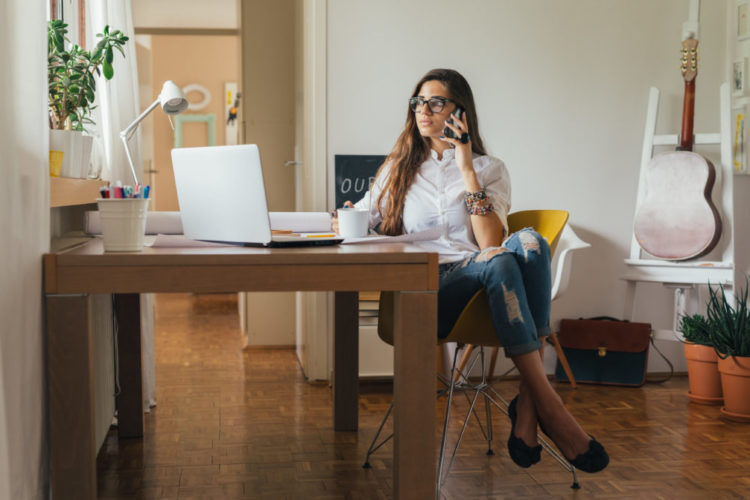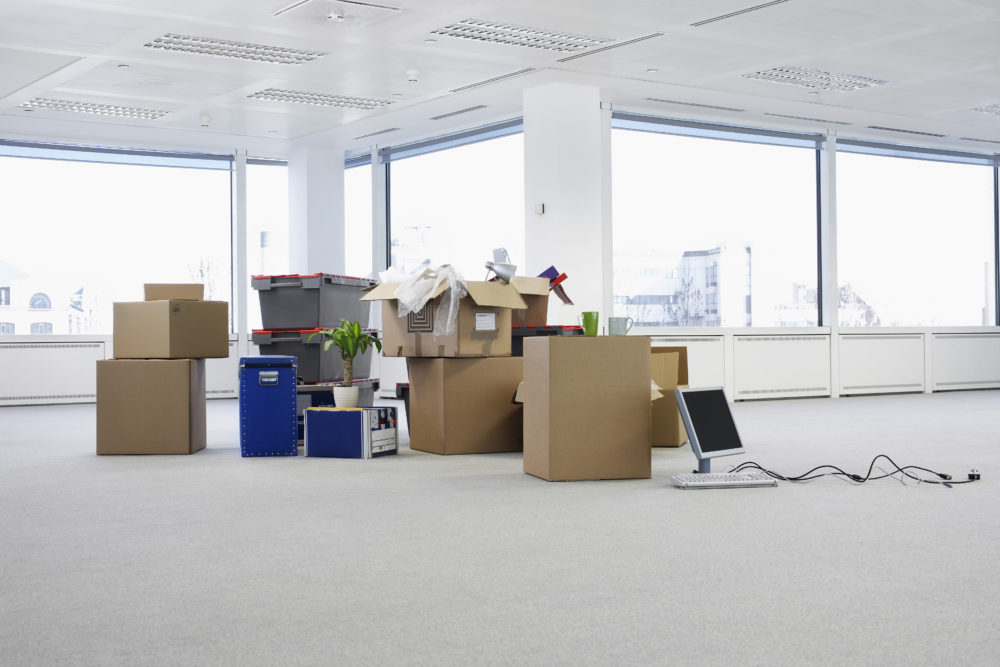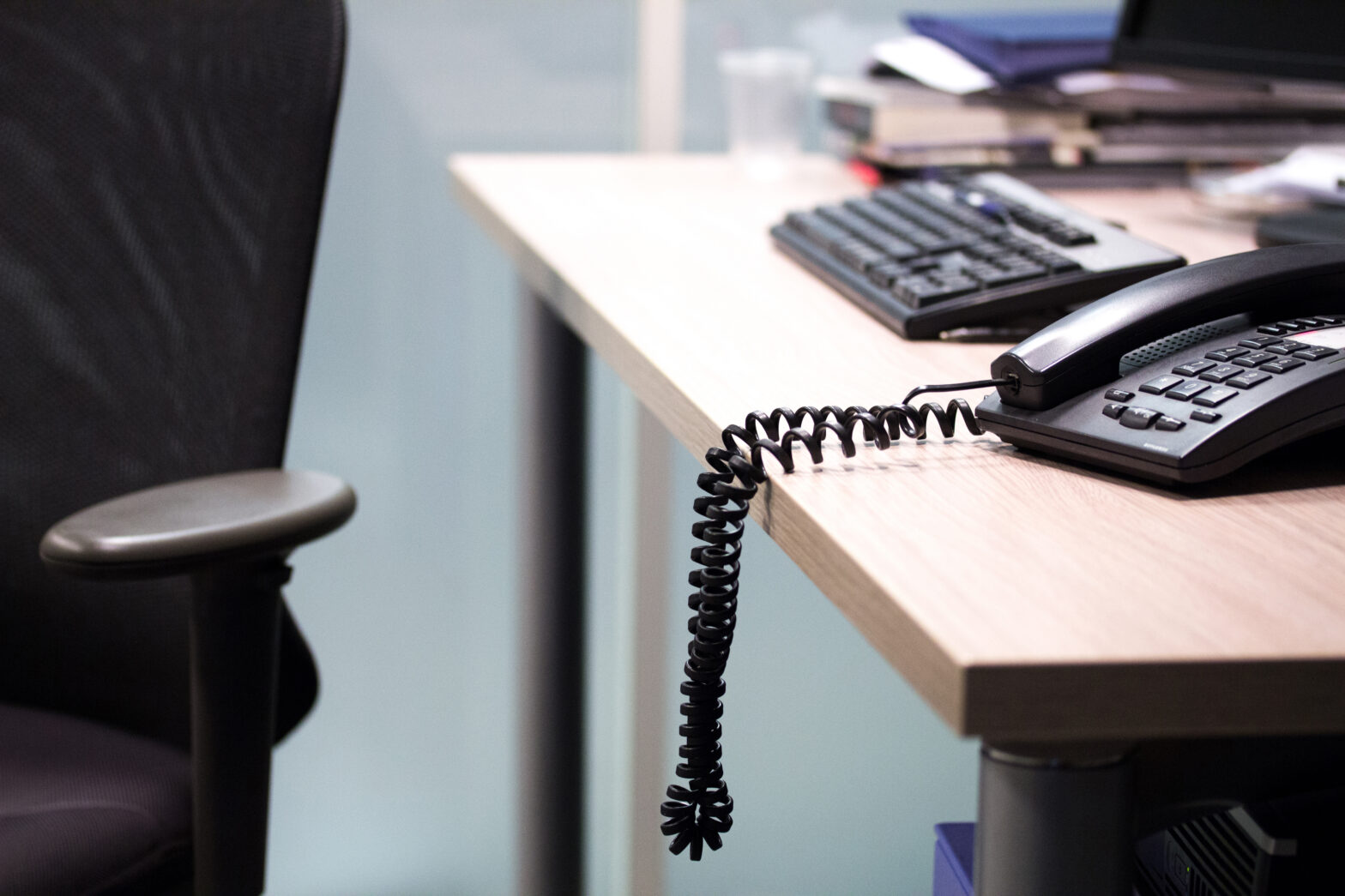More and more people are choosing to work for themselves – and for that, they need a home office which boosts their productivity while reflecting their personality.
There’s a lot to consider here. You’ll need to think about legal implications like insurance, practical things like a comfortable office chair and design features like colour and lighting.
If you have a bad set-up, your health could be at risk.
It’s an exciting project to immerse yourself in, but setting up shop can be daunting if you don’t know what to do.
Fretting about the task ahead? Take some advice from an expert and a handful of small business owners who started where you are now.
Top tips for setting up a home office
The team at Cleveland Containers offer their advice on creating a home office that’s right for you.
Separate work from home
When working from home on a regular basis, it’s important that you create a clear distinction between home and work life. This is especially true if you decide to invite colleagues or clients over in the future.
If you’re working whilst sprawled on the sofa or lying in bed, how productive do you feel? The answer is probably not very. By creating a separate office environment, you’ll retain the professional and productive feelings you’d get in a more traditional workspace.
Firstly, you need to identify the best place for your office. If you have a rarely-used guestroom, or a spare room that doubles up as storage space, then they could both be good options.
If you don’t have a spare room, that’s not a problem: you can build an office in your back garden instead. Sheds and shipping containers are spacious enough to house an office, without taking up too much garden space.
Creating a home office will help to retain your privacy, whilst ensuring you aren’t distracted. After all, no one can be productive if they can hear a TV blaring in the background.
Make the most of what you’ve got
If your office is small, you’ll want to make the most of the space you’ve got. A cluttered space is off-putting and can sometimes feel a little claustrophobic.
While we all have our own ways of working, and some prefer an ‘organised mess’, the key is still organisation. Maximise your space by storing paperwork into file dividers or boxes – they’ll also stop you from frantically searching for that one document for ten minutes.
Purchase a pair of drawers to store away other equipment or stationery that isn’t needed on your desk. You don’t have to spend a lot of money kitting out your office. A quick trip to IKEA will give you loads of ideas.

Invest in the right equipment
When you’re working remotely in your home office, one of the worst things that could happen is for your laptop to suddenly crash, or your broadband to stop working.
It’s worth spending a bit extra to ensure your technology is up to date and working properly. Have a local, responsive web team on speed dial so that if you do suddenly have any issues with your devices, you can get them fixed fast.
Related: Better Business Technology – Advice and guides on how to better your business through improvements in efficiency, technology and collaboration
When creating your home office, you’ll also need to ensure that there are enough plug sockets. You’ll need space to charge your laptop and phone, as well as having space to potentially plug in a printer and a lamp. It may be worth buying a plug extension so you have enough sockets.
Another highly important piece of equipment for your home office is a chair. When you’re sitting down for long periods of time, you want to make sure that your chair supports your back and neck, and helps with your posture. You can find ten of the best ergonomic office chairs here.
Choose the best colours
Like music and pictures, colours evoke certain emotions within us. Whilst you may not be overtly aware of this, colour is more powerful than you think, and is something to bear in mind when decorating your home office.
Avoid cool colours like blues and lilacs, which encourage feelings of peace. Relaxation is great for your bedroom, but not so much for your office!
Instead, you could incorporate purple into your decor, which is known to stimulate the imagination, or even a cheery yellow – provided it’s not too bright.
If you’re unsure about reaching for bright colours, then try neutral shades like grey and cream. They won’t cause distractions, and are a great base for creating a feature wall further down the line.
“Incorporate purple into your decor, which is known to stimulate the imagination, or even a cheery yellow”
Find natural daylight
Natural daylight improves our mood and makes us happier, which is why having a window in your office can be beneficial.
If you’ve chosen to house your office in a shed or shipping container, then you can usually modify them by getting a window built in. Placing your computer by the window means that you can gaze out whenever you want to give your eyes a break from the screen.
If a window isn’t an option then don’t worry, you can cheat it! There are lots of lamps out there that mimic daylight, so you can enjoy the benefits of natural light even though you’re faking it.
Research has shown that we respond better to yellow-cast illuminations, and a lack of light can have a negative effect, even causing depression through Seasonal Affective Disorder (SAD), so it’s important you don’t leave the lights down low.
Once you’ve got the lighting sorted in your home office, avoid eye strain caused by glare, by ensuring your computer isn’t directly in the line of your light source.
A well thought-out workspace will improve happiness and productivity, and the best thing is, these tips to setting up a home office won’t take up much of your time.
Carol Mann, co-founder of We Get Digital

Carol is based in north London with her husband. She talks about making the most of the available space you have.
There are a few questions you need to ask yourself when setting up your home office.
Are you going to have clients visit you? If so, make sure you have easy access to the office and that the bathrooms are always clean, tidy and presentable. It’s also a good idea to have coffee and tea making facilities nearby.
Even if you aren’t going to see anyone in your home office, make sure that it is a really organised space for your business.
Think carefully about the growth of your business and have a place for everything. Treat it exactly as you would a professional office space. This really sets the tone for the working day.
Make maximum use of the space you have. How many people can you realistically fit into the space? If it’s just one, do you need more desk space or more storage space? Measure up carefully and buy your large items accordingly.
It is important to have a really comfortable yet functional set up as you will be spending more hours in your office than you think!
Get some good, strong shelving in place with storage boxes. There are some great second-hand furniture shops for desks and filing cabinets – it won’t cost a fortune if you shop around.
Don’t skimp on comfortable and ergonomic chairs though.
Make sure the lighting is good – directional lamps and soft lighting work well. Dimmers are ideal because if you are working late at night, you can dim the lights and get on with your tasks more comfortably.
I will stress again to measure up carefully. You don’t need massive desk space. Assess exactly how much space you need to work on and in. How much paperwork are you likely to have? A lot can be stored electronically.
As for the colour scheme in my own office, I go neutral neutral neutral – there is enough colour in the books, boards, files and folders.
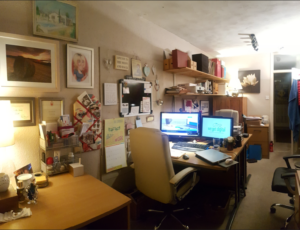
We have two large white boards for organising and top priority lists on the wall. We have some paintings and certificates and a few fun motivational signs. Finally, we have one magnetic board for pinning important papers to which we keep as clear as possible.
In the past, we spent time in our dining room where we had a desk/cupboard space built so that we had one area apart from the dining table that could be used. This meant that when the room we use for the office now was freed up we did have a good idea of exactly what we needed.
We didn’t actually build anything for our office. The house already had an extension which we were able to access once the children had left! It was just a question of decoration, purchasing the desks and storage and putting up adequate shelving.
We have professional indemnity insurance and our general home insurance which covers us too.
Jon & Kelly Barfoot, co-founders of Vegbred

Jon & Kelly Barfoot, co-founders of Vegbred®, a 100 per cent natural bread made with fresh sweet potato, prioritise simplicity and practicality in their home office.
Function over form is our motto! It’s easy to get carried away with style and feng shui but a home-based office should, most importantly, be a quiet space. It doesn’t need to be flash: a basic IT desktop, Wi-Fi and a good chair will be enough to get you going.
I started out by trying to work from the kitchen table – or anywhere from a laptop – for too long. Just bite the bullet, set up a spare room or free up some space in an office. You’ll save yourself a host of well-intended frustrations!
Although it’s fine to get going with just your home phone and a mobile, it’s best to put in a phone line with a different number early on. This is an obvious one, but it keeps business and home life separate. You can also run a line/hub as a business expense so it’s definitely worth considering.
When we first came up with the idea for Vegbred®, we were brainstorming innovative new bread flavours, discussing the next health food trends, all while juggling family life with three young ones. Thinking of ways to better separate the two would be our future recommendation; benefiting both home and work lives.
“It doesn’t need to be flash: a basic IT desktop, Wi-Fi and a good chair will be enough to get you started”
Keeping your office fitout cheap
You can save money by working with what you’ve got. For example, plugging in your laptop to a keyboard and monitor rather than splashing out on a new PC can keep your initial costs down.
It’s important to have a supportive chair at the right height for your desk. Likewise, good LED lighting is essential. Having the right equipment is important to your health.
We converted an old unused outbuilding into our original home office space but as we didn’t add any cooking or washing facilities or change the roofing, there wasn’t any need for planning permission.
However, we updated our insurance with the NFU to cover office contents and liability insurance for businesses. The NFU were particularly helpful with data protection requirements.
We knew we needed enough space to seat four people, with enough storage space to keep the desk clear. So, we created a large central desk that we all sat around, turned a wall into a large white board with plastic laminate covering and got some cheap desk lights from IKEA. The conversion was a simple dry lining with insulation, flooring electrics and IT cabling put in. To keep things simple, we used the washroom facilities in the house.
The colouring matches our brand look and feel – books, plants and pictures add colour too.
As a fresh food delivery business, we added maps and anything branded that we had created to the walls, along with interesting food photography.
Lloyd Cox, owner of The Human Codex

Lloyd Cox runs his business, The Human Codex, from his caravan. He travels around the world, but there are extra implications when you have a moving office.
In my office, space is crucial as well as heat. There is very limited space in a caravan, so you have to be mindful of what goes where, and you have to make sure laptops don’t overheat or have their fans blocked.
We have all the chargers and monitor cables hooked up that won’t move when we tow, but the laptops are easily moved so we can work outside when the weather is nice. You have to be as paperless as you can be!
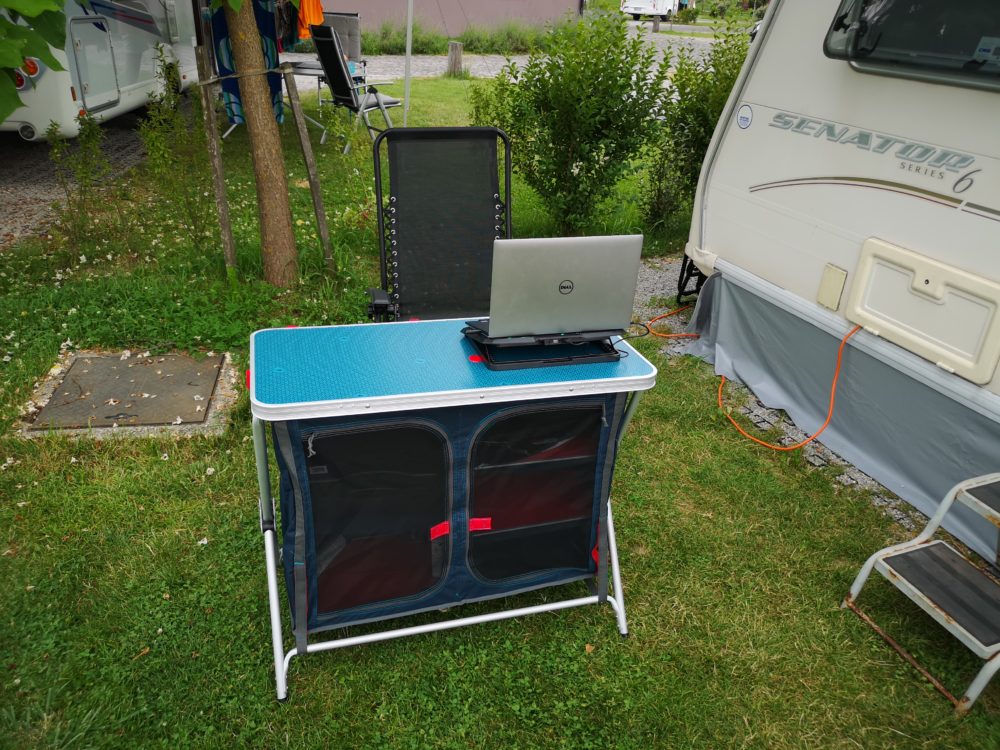
You have to be minimalistic with the tools you need as well, so everything must be essential. If something isn’t used on a daily basis, like a printer or scanner, it isn’t in there!
The biggest mistake I made was trying to have a PC in there – it took up too much space and overheated quickly. You just can’t lug a PC tower outside as easily as a laptop. We also made the mistake of trying to have equipment we didn’t need such as mouses and paper.
We almost lost quite a few important documents at first, but now everything is scanned so if the hard copy is lost we have an electric copy.
You have to be very careful of wattage in caravans too. Appliances plus laptops can easily blow the fuses!
We have normal caravan insurance (just for the van itself, but we also have travel and business insurance for everything we use). It’s not so easy to nip down to the shop to get a replacement, however the cover we have does deliver a replacement within the EU.
Using the space
We had to play with what we have – it’s important to be flexible. The layout for us is quite lucky as the bed is separate from where we work, although you can work from bed (one of the perks of remote working). The lighting can be tricky – there are plenty of windows, but with more light comes more heat, so it’s kind of a balancing act to make sure you can see but also don’t overheat.
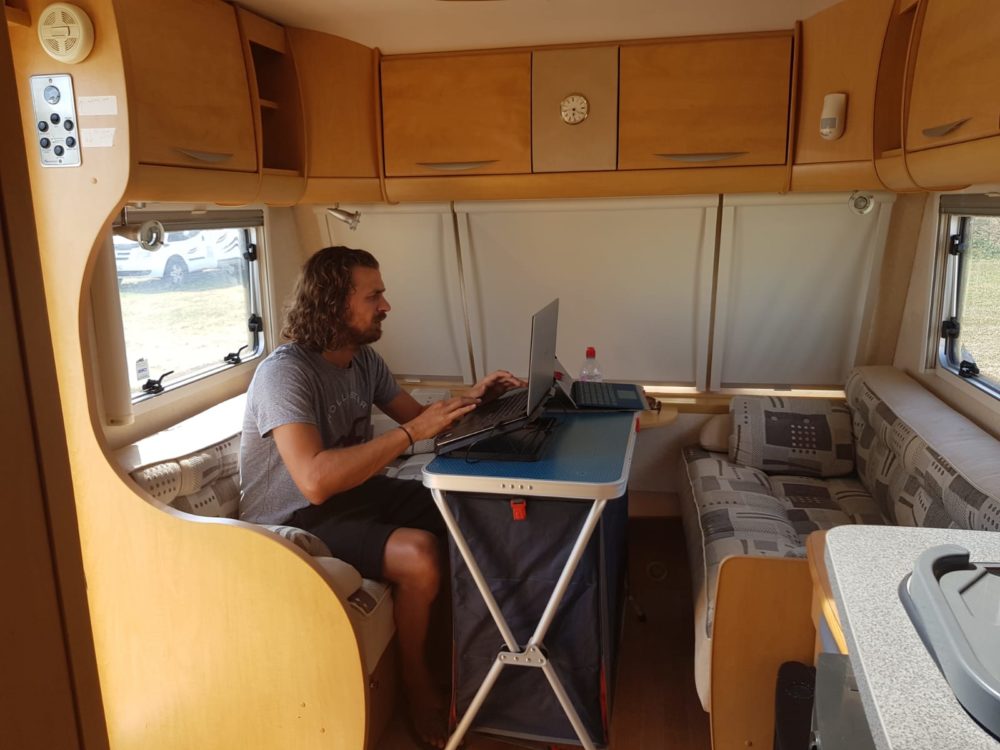
We haven’t changed the colour of the office section yet, although when we can. We would like to paint the office the colours we use on The Human Codex platform (white, grey and purple) but again, we need to be mindful not to make it too dark.
What actually goes on the walls is an ongoing debate between myself and Toni (CEO). I would love to have our logo and motto – ‘We each have a story to tell, we each have a lesson to teach’ – but it isn’t very practical with the limited space we have.
I’m trying to see if we can have both painted on the walls rather than have them hanging up.
Jessica Morgan, owner of Carnsight Communications

Jessica had to get planning permission for her converted garage, but the transformation (and the bi-fold doors) were definitely worth it.
Having worked at my kitchen table before, the most important thing for me in a home office was space – to be able to leave documents where I’d left them without having to hurriedly tidy up every evening and set things up every morning.
I wanted a dedicated space that was only occasionally used for something else (we have a sofa bed in here, so it can also be used as a spare room).
Doing up the garage
We did the work as part of an extension so planning permission was needed. We connected the detached garage to the house so there was quite a bit of work involved. Because we’re on the edge of the Cotswolds it was quite a strict process but being at the back of the house, we had more flexibility with this room. We’re covered on contents insurance with the house.
The key elements were a good desk, a printer and a filing cabinet. My layout then changed again when my first employee joined.
I also had to do a layout plan to know where sockets were going to go. Looking back, one of my biggest mistakes was not putting enough sockets in! I tried to anticipate where everything would go but I’d say, as a general rule, try and have sockets on every wall you can.
Having a space that was as separate from the house as possible was important, both for me and for people who come here. We have a bathroom here and there’s an area of the utility room which adjoins with a fridge, our kettle and a coffee machine so we don’t have to go into the kitchen at all.
I would have chosen underfloor heating next time as our radiator doesn’t keep us really warm on freezing cold days. There was a lot of snow last winter!
Forking out a bit more
I went for a slightly more expensive desk which felt sturdier and had a lot of space. I paid a bit more for office chairs because good posture is essential. Electronics-wise, I invested in a good Wi-Fi extender and a decent printer and cartridges. We have a good speaker and we spend quite a bit on coffee!
Bi-fold doors were probably the biggest expense but they’re definitely worth it in summer when we can work with them fully open.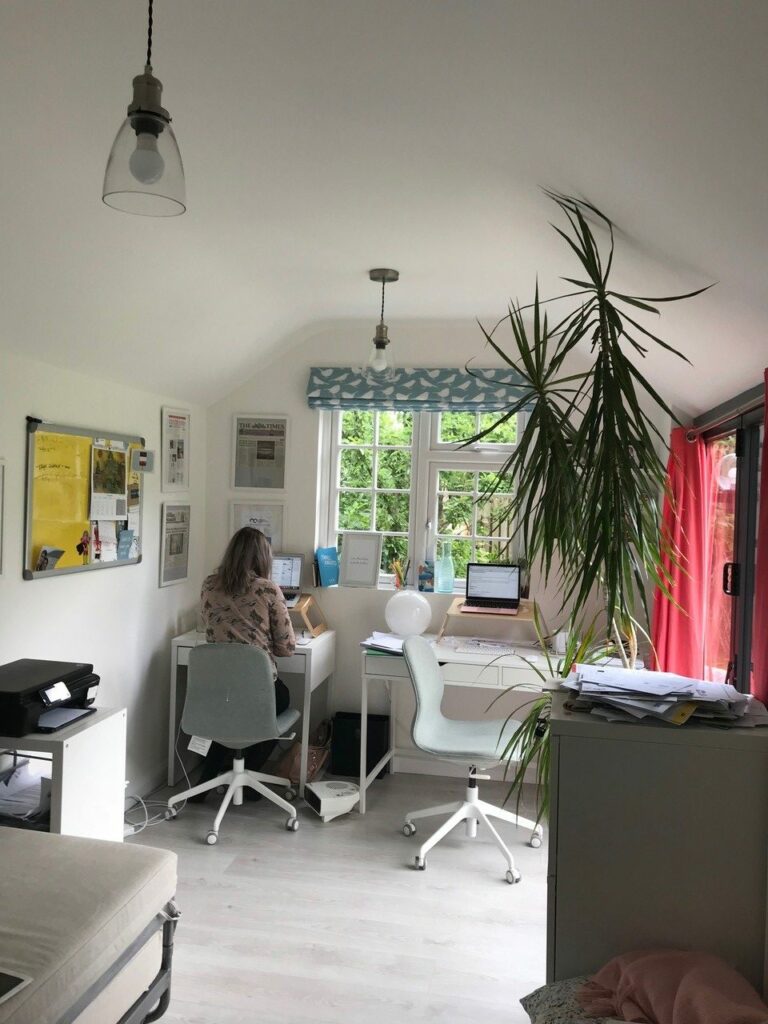
Frames on the wall were cheap as were picture ledges. We’ve got some personalised stationery but otherwise I have a back-up of cheaper pads and pens.
“I would have chosen underfloor heating next time as our radiator doesn’t keep us really warm on freezing cold days”
Getting the office feel right
The look was important to me as I wanted to enjoy spending time in there, so I chose complimentary neutral fittings and furnishings and cushions.
Maximising light was really important as we face south and I wanted to sit in front of a window to see the greenery in the garden. I chose white walls and a white wood effect floor as well as white and wood fittings and pendant lights.
We were working with designer Helen Baker at the time and she customised her garden birds print so we could use it as a blind in my favourite turquoise colour. It’s perfect as we often look up and see birds feeding outside the window. We have a bright yellow pinboard and wipe board and the other key bit of colour is the cushions on the sofa. We sit there to have catch-ups or have a coffee with clients.
It’s mainly light and pale in the office to maximise light and space with some splashes of colour. I think the pale colours also help us to feel calm when it gets frenetic.
Some of the recent coverage I’m proudest of is framed on the wall. For me, it’s important to celebrate the wins as you so quickly move on to the next project.
We have magazines and papers on picture shelves for reference and of course, some pictures of my children. We also have a bright yellow pinboard and wipe board so we can pin up things like thank you cards. The other painting is one by my great uncle, the artist Glyn Morgan.
Ingvar Gudmundsson, owner of SimplyBook.me

Icelandic entrepreneur Ingvar used to work flat-out before he built his current home office, which allows him to balance work and family life. He advises that you stay off the laptop for long-term work.
The first thing to consider is how you will arrange the work schedule so that you can participate in family life while still delivering an effective day at work.
A lot of people see a home office as a great opportunity to stay at home when taking care of children. Unfortunately, it’s not so easy. To have an effective home office it is important to separate your personal and professional areas while you are working. I remember times when my wife was out at work and our little one was only nine months old.
To give me work time, we would have him stay awake late in the evening to enjoy time with his mum, which gave me time to work, and then this allowed him to stay asleep ’til noon, giving me time to work the whole morning.
Once he’s awake, the concentration moves from the work and to the baby and not much gets done. However, by arranging the schedule between the parents like we did, I got a full working day, although not in continuity.
You will be torn to pieces mentally if you try to do both at same time!
The first time I had a home office, it was before I had children and I was simply always at work. From when I woke up, eating my breakfast by the computer, until I went to sleep in the evening, I hardly went out for fresh air. I just sat in my chair trying to achieve the goal I set for that day (I was programming), and if I achieved it earlier than I thought, I set a new goal for the same day.
Now I regret that I did not give myself a bit more time off to do sport or physical activity. I believe it would have done me good, and possibly left me being more productive.
Make it efficient for work and life
To have an effective home office, buy a screen and a good mouse and sit or stand by an office table. Don’t fall in the trap that you can work on your laptop long-term, it should only be used for working on directly short-term.
I used a laptop as my work station with the consequences of getting bad office injuries, which consisted of bad pains in the mouse finger which was becoming stiff, a tennis elbow as well as a back pain from always leaning forward. If you need to save money, get a cheap phone, and consider yourself off work when not by the computer.
In a home office we stare constantly at the screen, even in the evenings, so have a large screen and use a tool like f.lux to make the screen automatically dimmer in the evening. This also helps to keep your sleep routine intact, even if you’re working late.
I work a lot by the computer, but when I am off, I am no longer at work. If there is something serious, I can still receive calls, but I rarely use my phone for internet or email, so there is no need for an expensive phone.
“Use a tool to make the screen automatically dimmer in the evening. This helps to keep your sleep routine intact, even if you’re working late”
A good office chair is extremely important and it doesn’t need to cost thousands of pounds. Try them out and find a chair that keeps you in a comfortable working position. Another thing I would recommend is a table that can be raised. They don’t cost too much and allow you to change position while still being effective at work.
The finer details
I have never thought about the legal or safety requirements concerning having a home office. This is relevant in some countries where you need permission. But in other countries, there are no special legal requirements concerning this.
I recommend that entrepreneurs start paying themselves salaries when possible. Apply for grants and supports from the government while building the business when possible, this can aid in paying your salaries.
Always do everything according to rules, and never break laws like not submitting correct VAT returns. The sleepless nights alone would not be worth it.
Other Web Resources on Home Office set-ups
Includes some examples of home office designs for different types of businesses.
- Home Office Lighting Ideas – Advice from Ideal Home on how to brighten up your work space
- A Photo Gallery of Home Office Examples – Architectural Digest magazine has collected 65, (count ’em! 65!) home office examples to inspire you to design your own work-friendly space in your own home. Some lovely photos here to sift through.
- 40 Creative Office Organization Tips – clear up the clutter and make some space.
- The Art of the Hidden Desk – get some more inspiration on creative ways to free up space from this Pinterest gallery.
- Business Broadband Options for Small Companies – advice helping you to tailor the type of Internet connection best suited to your business office set-up.
- Becoming a Paperless Office – save time, money and space and you’ll find your day-to-day business becomes faster and more seamless than ever before.
- 15 Home Office Essentials You Didn’t Know You Needed – looking beyond the standard desk, chair and IT stuff, here are some innovative products that could be ideal for your personal office. We particularly like the footrest, clear wall calendar, and the ‘mug warmer cum phone charger’ – yes, this contraption will both charge your phone and keep your coffee hot (although not at the same time…)
Finally, looking for some inspiration?
How about this ‘Work From Home Office and Desk Setup Tour’ from Matthew Encina?
